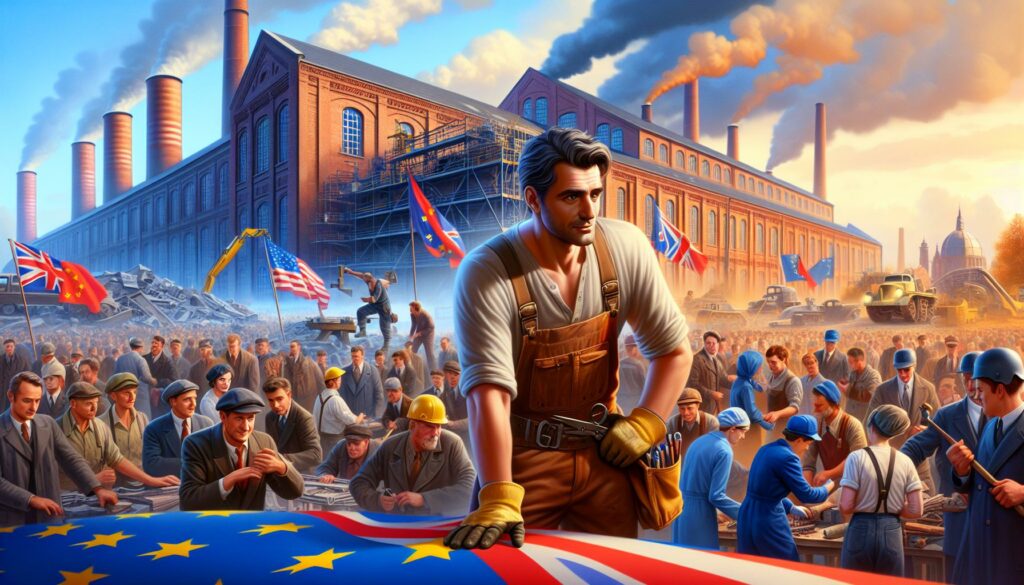The Marshall Plan stands as a pivotal moment in history, reshaping Europe in the aftermath of World War II. As I delve into the intricacies of this monumental initiative, I can’t help but appreciate how it not only revived economies but also fostered a sense of unity among nations. One aspect that often gets overlooked is the artistic representation of the plan itself, particularly through drawings that encapsulate its vision and impact.
These illustrations serve as powerful reminders of the hope and determination that characterized the era. They reflect the aspirations of a continent eager to rebuild and thrive. Join me as I explore the fascinating world of Marshall Plan drawings, uncovering their significance and the stories they tell about resilience and collaboration in a time of uncertainty.
Key Takeaways
- Significance of the Marshall Plan: The Marshall Plan was crucial in reviving post-World War II Europe, fostering economic stability and political unity among nations.
- Artistic Representations: Drawings associated with the Marshall Plan vividly depict themes of hope, collaboration, and recovery, serving as visual commentary on the initiative’s impact.
- Economic Transformation: Approximately $13 billion was allocated to support industrial growth and infrastructure rebuilding, leading to significant GDP increases across participating countries.
- Political Stability: The plan’s aid helped stabilize democracies in Europe, countering the rise of extremist ideologies and promoting international cooperation.
- Symbolism in Art: The drawings encapsulate essential elements of unity, resilience, and renewal, emphasizing the human experiences behind the economic and political changes.
- Legacy: The Marshall Plan’s enduring influence on European integration and cooperation highlights its role in shaping a peaceful and prosperous continent.
Marshall Plan Drawing
The Marshall Plan drawing showcases pivotal themes of recovery and solidarity. These illustrations represent a visual commentary on the economic revitalization of Europe post-World War II. Artists used various styles and techniques to convey messages of hope and determination, emphasizing the plan’s impact and significance.
Illustrations often depicted scenes of reconstruction, collaboration, and burgeoning industries. Many drawings featured iconic landmarks and everyday life, reflecting the aspirations of citizens eager to rebuild their futures. Artists captured the essence of the Marshall Plan’s goals: to foster economic stability, encourage collaboration among nations, and promote peace.
The drawings served multiple purposes, including propaganda and educational tools. They inspired nations and communities, reinforcing the belief in a united front against adversity. Each artwork encapsulated the spirit of an era focused on resilience, highlighting the importance of investment and support in shaping a better future for Europe.
By examining these drawings, one gains insight into the broader narrative of cooperation and renewal that defined the post-war period. Each piece evokes a response, urging viewers to reflect on the importance of unity during times of crisis.
Historical Context
The Marshall Plan emerged from a critical period marked by devastation and uncertainty in Europe. This section elaborates on the conditions that prompted its creation and the urgency for rebuilding a war-torn continent.
Post-World War II Europe
Post-World War II Europe faced severe challenges, including widespread destruction, economic collapse, and political instability. Infrastructure, such as roads, bridges, and factories, suffered extensive damage. Major cities like Berlin and Warsaw lay in ruins, with millions of people displaced. These conditions created fertile ground for the rise of extremist ideologies. Nations required both immediate aid and long-term strategies for recovery. The Marshall Plan aimed to address these pressing needs by stimulating economic growth and promoting democratic governance.
The Need for Reconstruction
The need for reconstruction in Europe became apparent as famine and poverty rose. By 1947, Europe’s economies stagnated, leading to a declining standard of living. Many countries relied on food aid and suffered from high unemployment rates. The pervasive fear of communism encouraged Western powers to act decisively. Economic revitalization was essential for preventing further instability and fostering cooperation among European nations. The Marshall Plan, with its financial assistance and support for rebuilding efforts, represented a concerted attempt to restore hope and promote unity across the continent.
Significance of the Marshall Plan Drawing
The Marshall Plan drawings hold considerable importance in illustrating the plan’s influence on post-war Europe. They symbolize the hope and determination of a continent striving for recovery, emphasizing the themes of economic revitalization and political unity.
Economic Impact
The economic impact of the Marshall Plan remains profound. The plan allocated approximately $13 billion (equivalent to over $150 billion today) for the reconstruction of war-torn Europe. This funding fueled industrial growth, restored infrastructure, and revives agricultural production. Many countries saw a GDP increase of around 15-20% in the years following the implementation. The drawings reflect scenes of factories reopening and farmers tilling fertile land, representing the resurgence of productivity and the promise of prosperity. Visual representations of economic transformation reinforce the message of collaboration, driving home the significance of unified efforts in economic recovery.
Political Implications
The political implications of the Marshall Plan resonate strongly within the drawings. The plan not only aimed to revive economies but also sought to curb the spread of communism by promoting democracy. The artwork often depicted cooperative projects between nations, highlighting a united front against the potential rise of totalitarian regimes. Countries that accepted aid exhibited less political unrest, further supporting democratic governance. The drawings serve as potent reminders of the power of international collaboration, illustrating how shared goals can foster stability and peace in a post-war landscape.
Analyzing the Visual Representation
Analyzing the visual representation of the Marshall Plan drawings reveals significant themes and artistic elements that encapsulate the spirit of post-war recovery. These illustrations reflect both the challenges and hopes of the era, inviting deeper exploration of their key components.
Key Elements of the Drawing
- Symbolism of Unity: The drawings often include figures representing various nationalities collaborating. This symbolizes the importance of cooperation in recovery efforts.
- Scenes of Reconstruction: Illustrations depict buildings being rebuilt and factories operating, visualizing the economic revitalization that the Marshall Plan aimed to achieve.
- Human Emotion: Artists capture expressions of hope, determination, and resilience on the faces of citizens, emphasizing the human impact of the Marshall Plan.
- Industrial Growth: Many drawings highlight scenes with machinery and workers, illustrating the industrial transformation fueling economic stability.
- Cultural Integration: The artwork frequently incorporates elements from different cultures, portraying the blending of traditions as nations collaborated for progress.
- Vibrant Colors: Artists utilize bright colors to evoke feelings of optimism and renewal, drawing viewers into the hopeful narrative of reconstruction.
- Dynamic Composition: Many drawings feature strong diagonals and movement, creating a sense of energy and urgency reflective of the recovery efforts.
- Realistic Detail: Attention to detail in architectural and human representations enhances authenticity, grounding the drawings in real experiences.
- Propaganda Influence: Some illustrations employ bold typography and striking visuals, typical of propaganda art, to convey messages about unity and recovery.
- Varied Mediums: Artists experimented with pencil, ink, and watercolor, showcasing a range of techniques that enriched the visual storytelling of the Marshall Plan’s impact.
Legacy of the Marshall Plan
The legacy of the Marshall Plan encompasses its long-lasting impact on Europe’s economic and political landscape. The initiative facilitated recovery across nations, promoting not only immediate relief but also sustainable growth. European countries rebuilt their infrastructure and economies, fostering a spirit of cooperation that persists today.
I observe that the Marshall Plan’s financial infusion, amounting to approximately $13 billion (over $150 billion today), stimulated industrial growth and increased productivity. Many European nations witnessed GDP growth rates of 15-20% in the years following its implementation. This substantial economic recovery laid the groundwork for future European integration and cooperation.
Artists’ drawings capturing the essence of the Marshall Plan serve as potent symbols of hope and resilience. These depictions reflect not only the physical rebuilding of cities and industries but also the emotional revival of a continent scarred by conflict. I find that such artwork highlights the importance of unity and collaboration in overcoming adversity, reinforcing collective aspirations for peace and stability.
The political ramifications of the Marshall Plan also shaped Europe’s trajectory. Countries that benefitted from the plan solidified democratic governance and formed alliances that would eventually lead to the establishment of the European Union. The drawings often portrayed scenes of collaboration, emphasizing the critical role played by the United States in fostering a democratic Europe while countering the spread of communism.
Overall, the Marshall Plan’s legacy indicates its significance as a transformative period that reshaped international relations and set the stage for modern Europe. The artistic representations capture this monumental effort, providing insight into a shared journey of recovery and unity that defined the post-war years.



